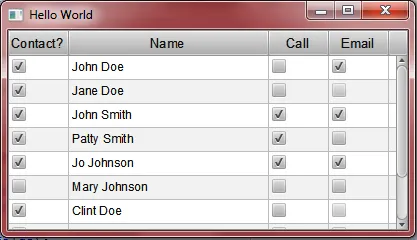我有一个带复选框的表格。当我点击第三或第四列中的复选框时,我想要改变第一列中的复选框的选择。我希望能够更改同一行中的其他单元格。我已经有了这些列,所以我想知道单元格所在的行。同时,我也非常不确定我到目前为止是否正确。我目前的做法主要参考以下内容:
- http://download.oracle.com/javafx/2.0/ui_controls/list-view.htm - http://download.oracle.com/javafx/2.0/ui_controls/table-view.htm - http://download.oracle.com/javafx/2.0/api/index.html?javafx/scene/control/Cell.html
- http://download.oracle.com/javafx/2.0/ui_controls/list-view.htm - http://download.oracle.com/javafx/2.0/ui_controls/table-view.htm - http://download.oracle.com/javafx/2.0/api/index.html?javafx/scene/control/Cell.html

这里是我的SSCCE(简短自包含可编译示例)
如果以下代码有任何问题,请纠正我。
package javafxapplication5;
import javafx.application.Application;
import javafx.beans.property.StringProperty;
import javafx.collections.FXCollections;
import javafx.collections.ObservableList;
import javafx.scene.Group;
import javafx.scene.Scene;
import javafx.scene.control.CheckBox;
import javafx.scene.control.TableCell;
import javafx.scene.control.TableColumn;
import javafx.scene.control.TableView;
import javafx.scene.paint.Color;
import javafx.stage.Stage;
import javafx.util.Callback;
public class JavaFXApplication extends Application {
private static final ObservableList<ContactOptions> addContactOption = FXCollections.observableArrayList(
new ContactOptions("Yes", "John Doe", "No", "Yes"),
new ContactOptions("Yes", "Jane Doe", "No", null),
new ContactOptions("Yes", "John Smith", "Yes", "Yes"),
new ContactOptions("Yes", "Patty Smith", "Yes", "No"),
new ContactOptions("Yes", "Jo Johnson", "Yes", "Yes"),
new ContactOptions("No", "Mary Johnson", "No", "No"),
new ContactOptions("Yes", "Clint Doe", "No", null),
new ContactOptions("Yes", "Sally Sue", "No", "Yes"),
new ContactOptions("Yes", "Bob Ryan", null, "Yes"),
new ContactOptions("No", "Mary Sue", "No", "No"),
new ContactOptions("Yes", "Bob Smith", "No", "Yes"));
private static TableView<ContactOptions> contactOptions = new TableView<ContactOptions>();
public static void main(String[] args) {
Application.launch(JavaFXApplication.class, args);
}
@Override
public void start(Stage primaryStage) {
primaryStage.setTitle("Hello World");
Group root = new Group();
Scene scene = new Scene(root, 400, 200, Color.LIGHTGREEN);
Callback<TableColumn, TableCell> cellFactory = new Callback<TableColumn, TableCell>() {
@Override
public TableCell call(final TableColumn param) {
final CheckBox checkBox = new CheckBox();
final TableCell cell = new TableCell() {
@Override
public void updateItem(Object item, boolean empty) {
super.updateItem(item, empty);
if (item == null) {
checkBox.setDisable(true);
checkBox.setSelected(false);
} else {
checkBox.setDisable(false);
checkBox.setSelected(item.toString().equals("Yes") ? true : false);
commitEdit(checkBox.isSelected() ? "Yes" : "No");
}
}
};
cell.setNode(checkBox);
return cell;
}
};
TableColumn firstCol = new TableColumn("Contact?");
firstCol.setPrefWidth(60);
firstCol.setProperty("one");
firstCol.setCellFactory(cellFactory);
TableColumn secondCol = new TableColumn("Name");
secondCol.setPrefWidth(200);
secondCol.setSortAscending(true);
secondCol.setProperty("two");
TableColumn thirdCol = new TableColumn("Call");
thirdCol.setPrefWidth(60);
thirdCol.setProperty("three");
thirdCol.setCellFactory(cellFactory);
TableColumn fourthCol = new TableColumn("Email");
fourthCol.setPrefWidth(60);
fourthCol.setProperty("four");
fourthCol.setCellFactory(cellFactory);
contactOptions.setItems(addContactOption);
contactOptions.getColumns().addAll(firstCol, secondCol, thirdCol, fourthCol);
contactOptions.setPrefSize(400, 200);
root.getChildren().add(contactOptions);
primaryStage.setScene(scene);
primaryStage.setVisible(true);
}
public static class ContactOptions {
private final StringProperty one;
private final StringProperty two;
private final StringProperty three;
private final StringProperty four;
ContactOptions(String col1, String col2, String col3, String col4) {
this.one = new StringProperty(col1);
this.two = new StringProperty(col2);
this.three = new StringProperty(col3);
this.four = new StringProperty(col4);
}
public String getOne() {
return one.get();
}
public String getTwo() {
return two.get();
}
public String getThree() {
return three.get();
}
public String getFour() {
return four.get();
}
}
}